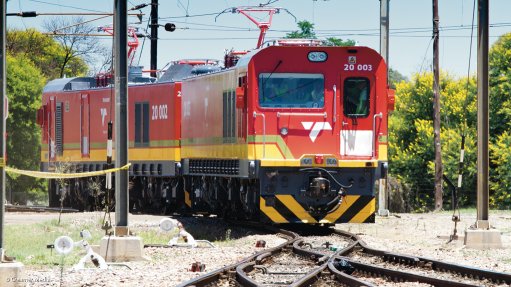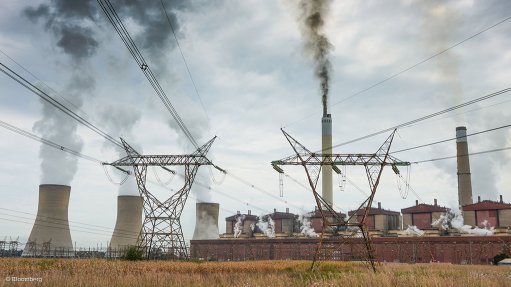GE’s gas power unit makes emergency-power submissions to DMRE


An example of a GE trailer-mounted mobile gas-powered solution than can be deployed as an emergency solution
The newly created gas power unit of General Electric (GE) has confirmed that it has made both direct and indirect submissions to the Department of Mineral Resources and Energy (DMRE) in response to a request for information (RFI) issued in December for 3 000 MW of emergency electricity solutions that could be “grid connected in the shortest time at the least possible cost”.
It is understood that the DMRE received hundreds of responses to the RFI by the closing date of January 31, but the department indicated last week that it was still evaluating the information and told Engineering News that it would comment only once all inputs had been processed.
During a recent visit to South Africa, GE Gas Power CEO Scott Strazik confirmed in an interview with Engineering News that GE had provided input to the DMRE through a direct submission and as part of three potential gas-to-power projects proposed by independent power producers.
The CEO of GE’s Gas Power business for sub-Saharan Africa, Elisee Sezan, indicated during the same interview that part of the offer was for the introduction of modular solutions that could inject between 300 MW and 500 MW of new generation capacity into the South African grid within six to nine months. These solutions would seek to tap existing liquefied petroleum gas supplies as a fuel source.
The other solutions were longer-term in nature and premised on South Africa building the port terminal capacity needed to facilitate the importation of liquefied natural gas (LNG).
State-owned logistics group Transnet is currently developing a business case for LNG infrastructure in both Richards Bay and Coega, while Total and Gigajoule signed a joint development agreement in December for a $350-million LNG importation terminal at the Matola harbour, in Maputo.
Strazik stressed that South Africa’s prevailing electricity deficit was in no way unique internationally, with several other countries also struggling to match supply and demand. “The South African situation is not dissimilar to those prevailing in various countries in Asia,” he explained.
Many of those countries were responding by installing gas-fired power stations, and had either already built, or were building, terminals to import LNG, which was increasingly available from countries such as Australia, Qatar and the US.
Strazik argued that gas-to-power would, in time, also emerge as an ideal complement to South Africa’s growing fleet of variable renewable energy generators that would be installed over the coming decades.
South Africa’s recently published Integrated Resource Plan 2019 envisages the introduction of 14 400 MW of new wind, 6 000 MW of new solar photovoltaic (PV), 2 088 MW of energy storage, 2 500 MW of imported hydro, 3 000 MW of gas and 1 500 MW of new coal by 2030. In addition, it has allocated at least 500 MW a year to distributed generation, which is most likely to arise in the form of solar PV.
“There is a transition happening across the world away from coal towards an exponentially larger renewables base that, in many cases, is being complemented by gas. It is being complemented by gas for two reasons: one, because gas is a cleaner alternative to coal, but also because gas has much faster ramping capabilities, which offers much more flexibility and is a better complement to renewables,” Strazik explains.
Given the combination of South Africa’s potent wind and solar resources and the rapid decline in technology costs, GE anticipates that the country’s renewables penetration will grow strongly. “In such a scenario, we believe gas will be a key enabler of that zero-carbon electricity by virtue of the fact that the technology can respond rapidly when the sun goes down and the wind stops blowing.”
Comments
Press Office
Announcements
What's On
Subscribe to improve your user experience...
Option 1 (equivalent of R125 a month):
Receive a weekly copy of Creamer Media's Engineering News & Mining Weekly magazine
(print copy for those in South Africa and e-magazine for those outside of South Africa)
Receive daily email newsletters
Access to full search results
Access archive of magazine back copies
Access to Projects in Progress
Access to ONE Research Report of your choice in PDF format
Option 2 (equivalent of R375 a month):
All benefits from Option 1
PLUS
Access to Creamer Media's Research Channel Africa for ALL Research Reports, in PDF format, on various industrial and mining sectors
including Electricity; Water; Energy Transition; Hydrogen; Roads, Rail and Ports; Coal; Gold; Platinum; Battery Metals; etc.
Already a subscriber?
Forgotten your password?
Receive weekly copy of Creamer Media's Engineering News & Mining Weekly magazine (print copy for those in South Africa and e-magazine for those outside of South Africa)
➕
Recieve daily email newsletters
➕
Access to full search results
➕
Access archive of magazine back copies
➕
Access to Projects in Progress
➕
Access to ONE Research Report of your choice in PDF format
RESEARCH CHANNEL AFRICA
R4500 (equivalent of R375 a month)
SUBSCRIBEAll benefits from Option 1
➕
Access to Creamer Media's Research Channel Africa for ALL Research Reports on various industrial and mining sectors, in PDF format, including on:
Electricity
➕
Water
➕
Energy Transition
➕
Hydrogen
➕
Roads, Rail and Ports
➕
Coal
➕
Gold
➕
Platinum
➕
Battery Metals
➕
etc.
Receive all benefits from Option 1 or Option 2 delivered to numerous people at your company
➕
Multiple User names and Passwords for simultaneous log-ins
➕
Intranet integration access to all in your organisation

















